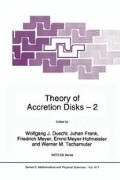Abstract
I review three current research topics in the observational study of the accretion disks in cataclysmic variable stars: the star-disk connection, eclipse mapping developments, and HST observations. First, an R -3/2 emissivity is inferred from the double-peaked velocity profiles of H I and Ca II emission lines from the chromospheres of quiescent accretion disks. There appears to be a direct analogy between these quiescent disk chromospheres and the dynamo-generated chromospheres of rotating stars. In both cases the H I and Ca II line emissivities scale roughly linearly with rotation rate. This observational evidence suggests that dynamo action powers the emission lines from quiescent accretion disks. Second, a new eclipse-mapping study of 6 long-period nova-like variables reveals that their optically-thick disks have temperature-radius profiles that are flatter than expected for a steady-state disk, and become progressively flatter as the binary period decreases toward 3 hours. As these nova-like systems are thought to be in a steady state, the anomalous eclipse maps hint that an important piece of physics is missing in our understanding of these disks. A likely candidate is non-radiative cooling related to driving of a wind from the inner disk. Eclipse mapping techniques are also now being pressed to a new frontier by mapping disks at hundreds of wavelengths and thereby recovering spectra from each position on the disk surface with sufficient resolution to see fines transitioning from absorption to emission. This offers vastly improved constraints on models of disk atmospheres that should make it possible to probe vertical structure. Finally, partly-digested results from HST observations of the cataclysmic variables OY Car, AE Aqr, IP Peg, and GP Com are presented to illustrate some of the new puzzles we are confronting as we begin to use high time resolution in the ultraviolet regime to study the hotter parts of accretion flows
Access this chapter
Tax calculation will be finalised at checkout
Purchases are for personal use only
Preview
Unable to display preview. Download preview PDF.
References
Balbus & Hawley 1991, ApJ, 376, 214
Donati, Semel, & Rees 1992, A&A, 265, 669
Donati, Brown, Semel, Rees, Dempsey, Matthews, Henry, & Hall 1992, A&A, 265, 682
Galeev, Rosner, & Vaiana 1979, ApJ, 229, 318
Horne & Cook 1985, MNRAS, 214, 307
Horne & Marsh 1986, MNRAS, 218, 761
Horne & Saar 1991, ApJ, 374, L55
Horne & Steining 1985, MNRAS, 216, 933
Lambert & Slovak 1981, PASP, 93, 477
Marsh & Horne 1988, MNRAS, 235, 269
Marsh & Horne 1990, ApJ, 349, 593
Marsh, Horne & Rosen 1991, ApJ, 366, 535
Marsh, Horne, Schlegel, Honeycutt, & Kaitchuck 1990, ApJ, 364, 637
Nather, Robinson, & Stover 1981, ApJ, 244, 269
Patterson 1979, ApJ, 234, 978
Robinson 1980, ApJ 239, 961.
Rutten 1987, A&A, 177, 131
Rutten, Dhillon, Horne, Kuulkers, & van Paradijs 1993, Nature, 362, 518
Rutten, Schrijver, Lernens, & Zwaan 1990, A&A, 252, 203
Rutten, van Paradijs, & Tinbergen 1992, A&A, 260, 213
Saar 1988, ApJ, 324, 441
Schrijver 1987, AkA 172, 111
Schrijver 1992, A&A 258, 507
Smak 1969, Acta Astron, 19, 155
Smak 1981, Acta Astron, 31,396
Stover 1981, ApJ, 248, 684
Thorstensen, Ringwald, Wade, Schmidt, & Norsworthy 1992, AJ, 102, 272
Tout & Pringle 1992, MNRAS, 259, 604
Ulmschneider, Priest, & Rosner 1991, Mechanisms of Chromospheric and Coronal Heating. Springer-Verlag, Berlin
van Paradijs, Kraakman, & van Amerongen, 1989, A & AS, 79, 205
Warner & Nather 1971, MNRAS, 152, 219
Welsh, Horne, & Oke 1993, ApJ, 406, 229
Williams 1980, ApJ, 235, 939
Young, Schneider, & Shectman 1981a, ApJ, 245, 1035
Young, Schneider, & Shectman 1981b, ApJ, 245, 1043
Author information
Authors and Affiliations
Editor information
Editors and Affiliations
Rights and permissions
Copyright information
© 1994 Springer Science+Business Media Dordrecht
About this paper
Cite this paper
Horne, K. (1994). Accretion Disks in Cataclysmic Variable Stars: Recent Observational Developments. In: Duschl, W.J., Frank, J., Meyer, F., Meyer-Hofmeister, E., Tscharnuter, W.M. (eds) Theory of Accretion Disks — 2. NATO ASI Series, vol 417. Springer, Dordrecht. https://doi.org/10.1007/978-94-011-0858-4_6
Download citation
DOI: https://doi.org/10.1007/978-94-011-0858-4_6
Publisher Name: Springer, Dordrecht
Print ISBN: 978-94-010-4370-0
Online ISBN: 978-94-011-0858-4
eBook Packages: Springer Book Archive

